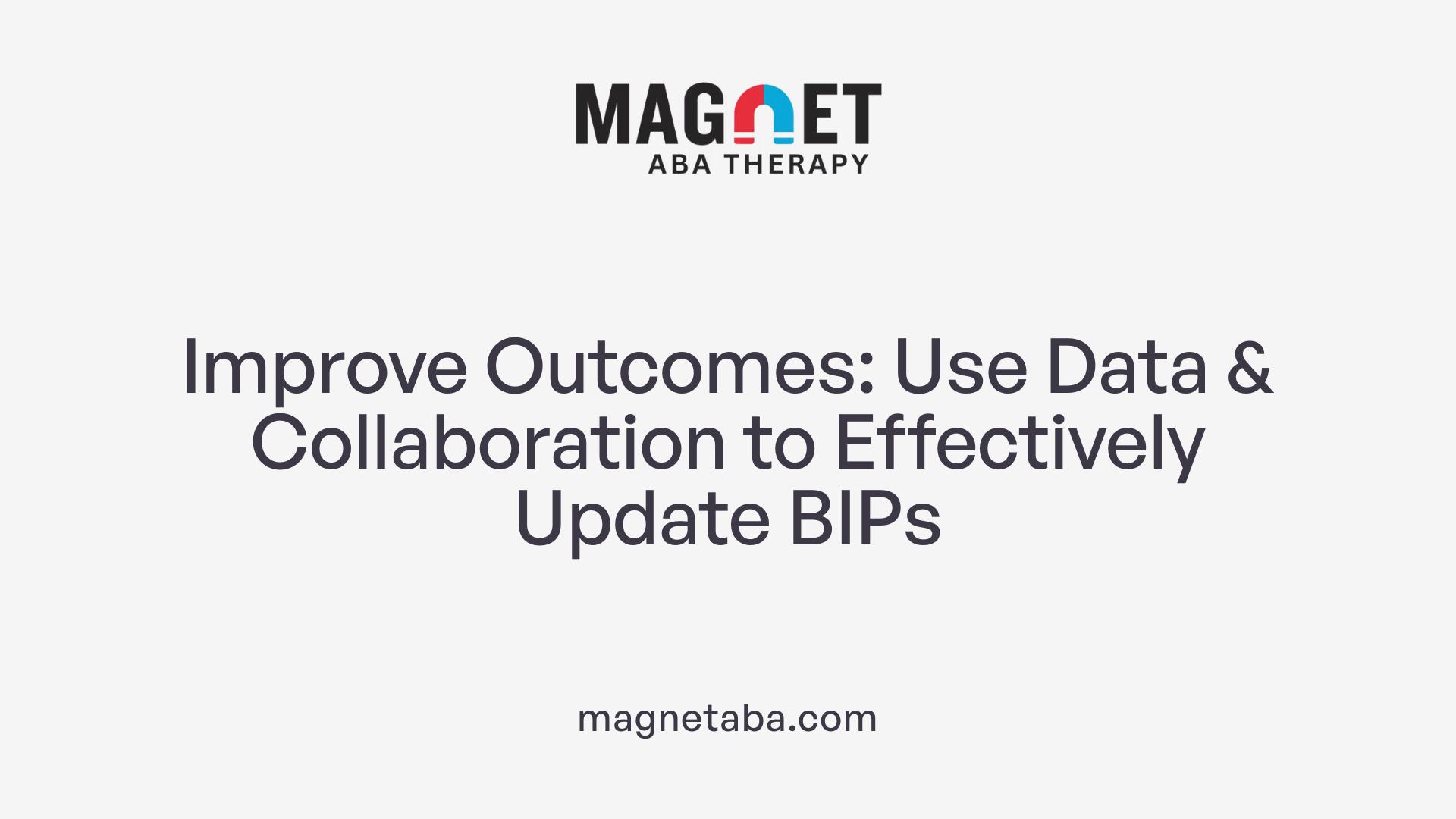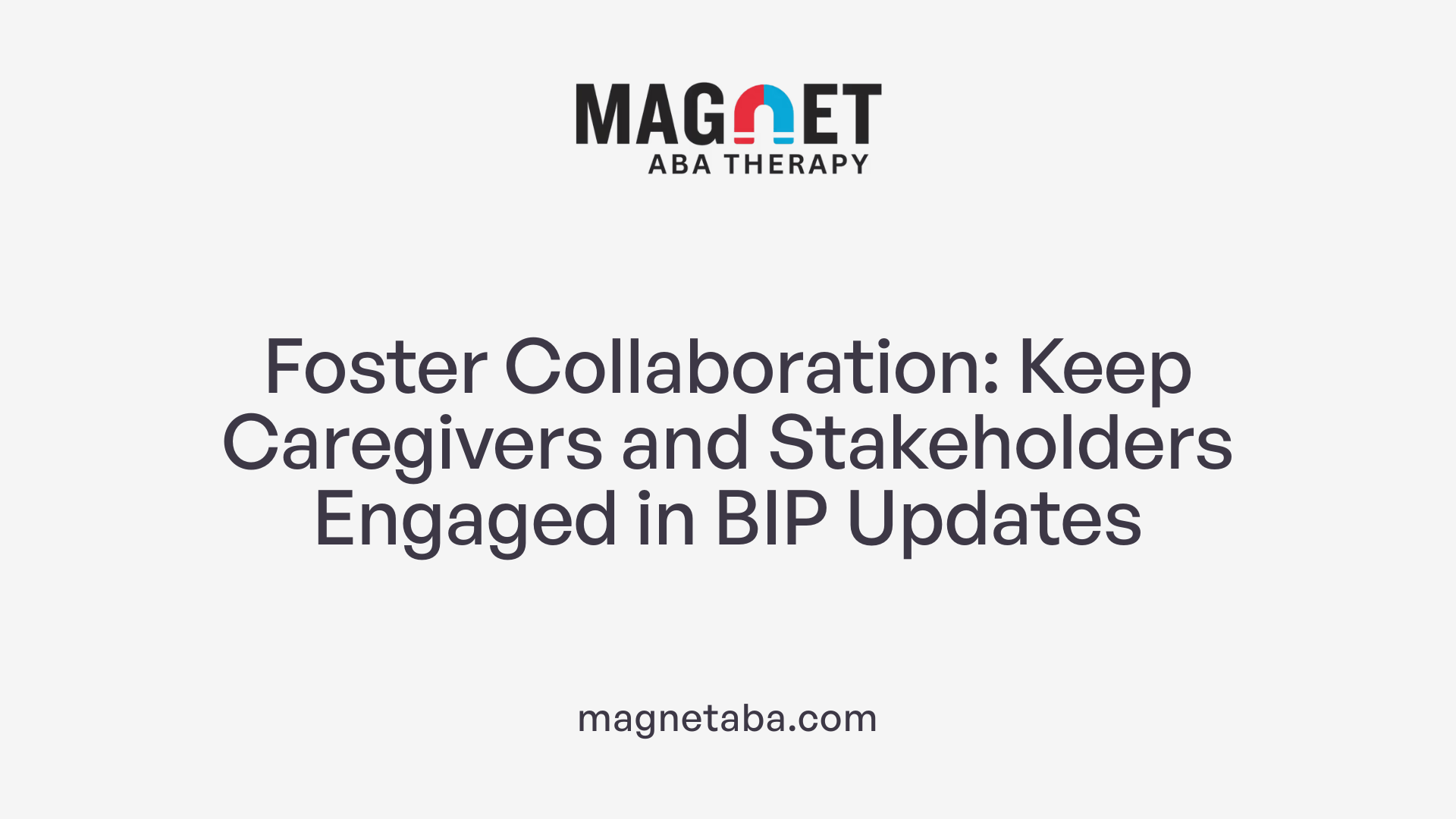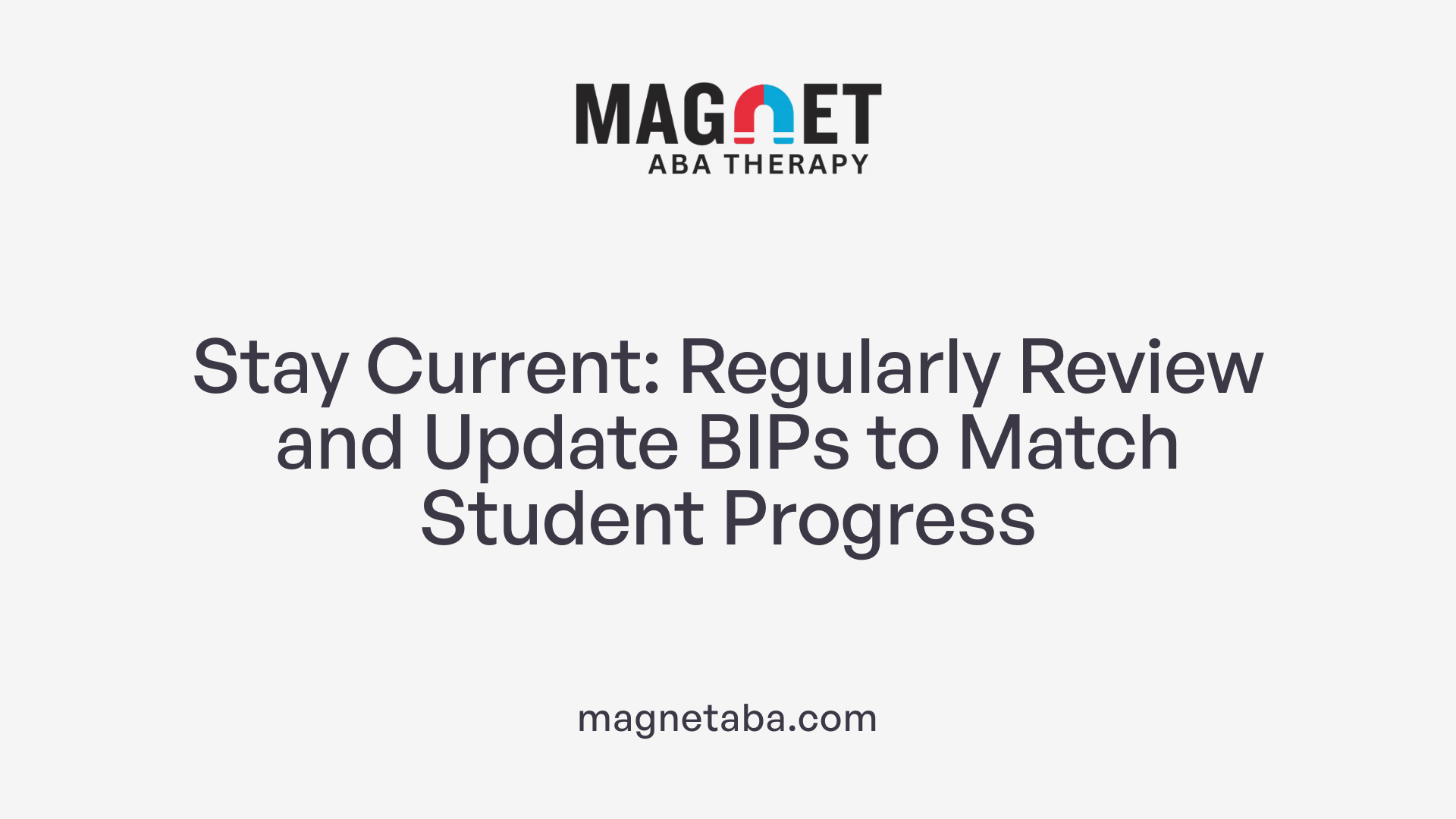The Importance of Regular and Responsive BIP Reviews
A Behavior Intervention Plan (BIP) is a dynamic document that requires ongoing evaluation and adjustment to remain effective in supporting individuals with challenging behaviors. Understanding when and how to update a BIP is vital for educators, clinicians, and stakeholders aiming to promote positive outcomes. This article explores key indicators for revising BIPs, best practices for updates, stakeholder involvement, legal considerations, and timing strategies to ensure interventions are always aligned with the individual's current needs.
Regular Scheduling and Critical Triggers for BIP Review
When should a behavior intervention plan (BIP) be reviewed and updated?
A Behavior Intervention Plan (BIP) must be regularly reviewed and revised to stay aligned with the student's changing needs. Most professionals recommend reviewing the plan every 6 to 12 weeks, providing a scheduled opportunity to assess effectiveness, adjust strategies, and incorporate new information. This routine ensures that support remains relevant and supports the child's progress.
In addition to scheduled reviews, certain critical situations necessitate an immediate update of the BIP. For instance, if there are significant changes in the student's behavior—such as regression, emerging behaviors, or stasis where little to no progress is observed—the BIP should be revisited. Such data should be collected meticulously, including frequency, duration, and intensity of behaviors, and analyzed to determine if the current plan adequately addresses the new challenges.
Environmental shifts also demand attention. Moving to a new classroom, changes in caregivers, or major environmental modifications can affect behavior and require reevaluation of the BIP to ensure its strategies are still suitable. For example, if a student begins to exhibit new behaviors in a different setting, the plan must be adapted to accommodate these contextual variables.
The emergence of new behaviors is a signal that gaps exist in the existing intervention. These behaviors might serve different functions than previously identified, prompting the team to update reinforcement strategies or teach new replacement skills accordingly.
Stakeholder feedback plays a crucial role in the review process. Parents, teachers, support staff, and the student themselves offer valuable insights into the plan’s practicality, feasibility, and emotional impact. If concerns arise about the strategies being distressing, disrespectful, or misaligned with the student's values and dignity, the BIP needs to be revisited to ensure it remains trauma-informed, promotes autonomy, and respects the individual.
Situations involving disciplinary actions also trigger the need for reassessment. Specifically, if a student with a disability faces suspension exceeding 10 days or potential expulsion, the IEP team must review the behavior causing such disciplinary measures. A Functional Behavioral Assessment (FBA) is required to understand if the behavior is related to the disability, and a revised BIP should be developed to prevent recurrence.
Importantly, even when a BIP appears effective, ongoing review helps identify what factors contribute to success. It allows the team to recognize supports that can be faded and to foster intrinsic motivation by reinforcing positive behaviors in meaningful ways.
To maintain an adaptive and effective support system, educators and behavioral specialists should build a routine of reviewing the BIP every 6 to 12 weeks. This regular schedule helps ensure the plan remains responsive to the student's internal development and external circumstances.
Including the individual's voice in these reviews enhances the plan’s effectiveness. Engaging the student actively in discussions about their goals and preferences makes the interventions more aligned with their identity, comfort, and long-term success.
Strategies that cause distress or are no longer effective should be promptly discontinued. Flexibility and responsiveness are vital; the BIP must evolve based on ongoing data and individual needs.
A holistic approach to behavioral support recognizes connections beyond the immediate behaviors. It considers the child’s relationships, emotional regulation skills, executive functioning, and environmental supports, integrating the BIP into broader frameworks of well-being.
In the school context, positive behavior interventions must be prioritized for students whose behaviors interfere with learning—regardless of whether these behaviors are directly linked to their disability. This approach emphasizes proactive support over punitive responses.
If disciplinary measures like suspension or expulsion are involved, and these last more than ten days, the school must evaluate if the behavior is disability-related. When it is, the team must conduct an FBA and develop or revise the BIP accordingly.
The process of reviewing and updating the BIP involves collecting and analyzing data through various methods. Direct assessments such as observations and functional analyses, along with indirect assessments like record reviews and interviews, provide comprehensive information about behavior function.
The purpose of these assessments and subsequent plan revisions is to replace problem behaviors with appropriate, functional alternatives. This ongoing process ensures intervention strategies remain effective, ethical, and respectful.
Regular review practices—integrating stakeholder feedback, analyzing behavioral data, and considering environmental factors—are essential for creating responsive and individualized behavioral support plans. This continuous process enhances the chances of success for students with behavioral challenges.
Recognizing Signs That Indicate a BIP Needs Revision
What are signs that indicate a behavior intervention plan (BIP) needs revision?
A Behavior Intervention Plan (BIP) is designed to help support students with challenging behaviors. However, it’s essential to regularly assess whether the plan remains effective and appropriate. Several signs signal that a BIP may need to be reviewed and revised.
One primary indicator is the persistence or escalation of problematic behaviors. If a student continues to display challenging behaviors despite consistent implementation of the current strategies, it suggests that the plan may not be effectively addressing the root causes or maintaining behaviors.
The emergence of new behaviors is another critical sign. When students develop additional problematic behaviors not previously observed, it might mean the existing plan doesn’t cover these new concerns or fails to teach necessary skills.
Environmental or contextual changes also warrant a review. Such shifts could include moving to a different classroom, changes in caregivers or staff, or adjustments in the daily routine. These modifications can impact behavior and the effectiveness of the current plan, making a revision necessary to adapt strategies appropriately.
Feedback from stakeholders such as teachers, family members, and support staff provides valuable insights. If they express concerns about the feasibility, consistency, or appropriateness of the interventions, it could indicate that the plan isn’t meeting the student’s evolving needs or that it’s difficult to implement correctly.
A lack of progress or regression in behavior data is another sign. When data shows little to no improvement or even worsening of behaviors over time, this suggests the current interventions are ineffective or misaligned with the student’s function of behavior.
Finally, there must be an ongoing assessment to ensure the intervention strategies match the behavioral function. A mismatch—when strategies do not align with the reasons behind behaviors—can hinder success and requires updating the BIP to better target the underlying causes.
It’s crucial to recognize these signs early and engage in timely revisions. Regular review routines—every 6 to 12 weeks—help ensure the plan remains responsive to the individual’s changing needs, maximizing positive outcomes and fostering a supportive learning environment.
Strategies for Updating a BIP to Achieve Better Outcomes

How can a BIP be effectively updated to improve behavioral outcomes?
Updating a Behavior Intervention Plan (BIP) is a crucial step in ensuring continued progress for students with challenging behaviors. The process demands a thorough review of recent data and careful consideration of changes in the individual’s environment and needs.
First, the cornerstone of effective updates is analyzing ongoing behavioral data. This involves examining the frequency, duration, and severity of behaviors to identify trends or patterns. When data shows little to no improvement, or even regression, it signals that the current strategies may no longer be effective or appropriate.
Incorporating recent assessment results, especially from functional behavioral assessments (FBAs), helps clarify whether the behavior’s function has shifted or if environmental factors are contributing to the difficulty. These insights guide the modification of intervention components for increased relevance.
Environmental and instructional adjustments are vital. This can mean changing the classroom setup to reduce triggers, adjusting schedules to better match the student's needs, or modifying teaching methods to foster engagement and reduce frustration.
Teaching replacement behaviors is another critical aspect. When updating the BIP, it’s important to identify and reinforce skills that serve the same function as the challenging behavior—these are known as functionally equivalent replacement behaviors (FERBs). Properly teaching these behaviors involves clear, consistent instruction and reinforcement.
Stakeholder involvement also enhances the update process. Regularly involving teachers, support staff, families, and even the students ensures that the plan reflects real-world needs and that everyone understands and commits to its strategies. Gathering feedback on what is or isn't working in different settings helps tailor the intervention more effectively.
Finally, incorporating recent assessment data, including additional FBAs and progress monitoring reports, allows for precise adjustments. This might include discontinuing strategies that cause distress or are not producing meaningful outcomes and replacing them with more suitable approaches.
Regular review routines, ideally every 6 to 12 weeks, facilitate responsiveness to the student’s changing needs, ensuring that the BIP remains effective and supportive. This periodic review not only helps in tracking progress but also in fostering a proactive mindset toward behavior management.
| Aspect | Focus Area | Details |
|---|---|---|
| Data Analysis | Monitoring Progress | Examine frequency, duration, and patterns of behavior |
| Environmental Adjustments | Modifications | Change classroom setup, routines, and instructional methods |
| Teaching Replacement Behaviors | Skill Development | Use clear instruction and reinforcement to teach FERBs |
| Stakeholder Input | Collaboration | Involve educators, families, and the child in reviewing and revising |
| Recent Data Use | Informed Decisions | Incorporate latest assessments and progress reports |
In summary, updating a BIP effectively requires a comprehensive, data-driven approach coupled with responsive modifications and collaborative input. These strategies collectively ensure that the plan remains tailored to the student's evolving needs, ultimately leading to better behavioral outcomes.
The Process and Considerations for Modifying a BIP

How do you analyze current data and behaviors to inform BIP modifications?
Effective modification of a behavior intervention plan (BIP) starts with a thorough analysis of existing data. This includes reviewing behavioral data collected through direct observations, functional behavioral assessments (FBA), and reports on problem behaviors. Key aspects include tracking frequency, duration, and intensity of behaviors, as well as identifying triggers and patterns that might contribute to the behavior.
Understanding the function of the behavior is critical. If data shows little to no improvement or regressions, it's necessary to reassess whether the current strategies align with the behavior's antecedents and maintaining variables. Changes in behavior, whether improvements or setbacks, signal the need for a plan review.
Also, environmental shifts—like moving to a new classroom or changes in caregivers—must be considered as they can alter behavioral contexts and necessitate plan adjustments. Analyzing the data in these new contexts helps determine if current interventions remain appropriate or if they need to be tailored to better fit the new settings.
Why is stakeholder feedback and acceptability ratings important?
Stakeholder insights from teachers, support staff, parents, and the individual are valuable in shaping effective BIPs. Their feedback highlights issues related to the feasibility of intervention strategies, staff comfort, and the child's response outside structured settings.
Acceptability ratings, often gathered through surveys, measure how acceptable and practical a plan's components are perceived to be by those implementing it. High acceptability correlates with higher implementation fidelity—meaning staff are more likely to follow the plan as designed. When staff rate components favorably, it can directly lead to improved reliability in the intervention's application.
Including the family’s voice ensures that strategies are culturally responsive and aligned with the individual’s preferences, values, and routines. This collaborative approach fosters trust and motivation among everyone involved.
How should reinforcement and teaching strategies be adjusted?
Monitoring student responses and data outcomes reveals when reinforcement methods or teaching strategies need revision. If certain reinforcement techniques no longer produce desired behaviors or cause distress, they should be replaced with more effective approaches.
Adjustments might involve switching to more motivating praise, altering reinforcer types, or increasing opportunities for skill acquisition that serve the same function but are more acceptable or manageable.
Teaching replacement behaviors must also be revisited. If students are not generalizing new skills, or if the behaviors are not maintained, the plan should incorporate more explicit instruction, practice opportunities, or environmental supports.
Why is ongoing monitoring of implementation fidelity essential?
Tracking how faithfully staff follow the BIP ensures that the strategies are being applied correctly and consistently. Implementation fidelity directly impacts the effectiveness of interventions.
Regular observations, checklists, and fidelity measures help identify deviations or barriers in implementation. If the plan isn’t producing expected outcomes, fidelity checks allow for pinpointing issues—whether related to staff understanding, environmental factors, or resource availability.
When deviations are identified, targeted training or modifications can be made to improve consistency, making the intervention more likely to succeed.
How do ethical and culturally responsive practices influence BIP revisions?
Revising a BIP with attention to ethics and cultural responsiveness ensures respect for the individual’s dignity, autonomy, and cultural background. If current strategies cause distress, are inconsistent with the individual’s values, or raise concerns about trauma or long-term well-being, the plan must be re-evaluated.
Incorporating culturally relevant reinforcement and communication methods promotes engagement and respect. Ensuring strategies are trauma-informed and promote positive relationships helps build trust and reduces potential harm.
It is also crucial to involve families and cultural consultants when necessary, to adapt interventions that are appropriate across diverse backgrounds and experiences.
What is the process for modifying a BIP to improve outcomes?
Modifying a BIP involves a collaborative, structured process that starts with comprehensive data review. The team—comprising educators, therapists, caregivers, and sometimes the student—analyzes behavioral data and gathers stakeholder feedback.
Functional behavioral assessments guide understanding of the behavior's purpose, forming the basis for strategic adjustments.
Based on insights from data and feedback, the team revises reinforcement methods, environmental supports, and teaching strategies to increase effectiveness and acceptability.
Throughout this process, continuous monitoring is essential to observe the impact of changes. Fidelity checks ensure strategies are implemented as planned.
If modifications lead to improved behavior, they are documented and integrated into the BIP formally. When issues persist, further revisions are made, maintaining a flexible approach.
Engaging all team members—including the individual when possible—ensures coherence and boosts the likelihood of sustained success. Regular review intervals, typically every 6 to 12 weeks, keep the BIP responsive to changing needs.
Involving families early, especially when behaviors vary across settings or in telehealth contexts, supports generalization and consistency outside the school environment. The goal is always to create a plan that is responsive, ethical, and tailored to promote positive, meaningful behavioral outcomes.
Stakeholder Involvement: Ensuring a Collaborative Approach

When and how should caregivers and stakeholders be involved in updating a BIP?
Involving caregivers and stakeholders throughout the process of updating a Behavior Intervention Plan (BIP) is crucial for creating effective and sustainable behavior support strategies. Their participation should not be a one-time event but an ongoing process that occurs at multiple points in the review cycle.
Caregivers and stakeholders should be actively engaged during initial plan development, after Functional Behavioral Assessments (FBAs) are completed, and whenever significant modifications to the interventions are considered. These moments are critical to ensure that the BIP is realistic, culturally sensitive, and aligned with the student's home and community environments.
Continuous involvement involves holding regular review meetings where team members, including teachers, support staff, family members, and the student (when appropriate), discuss progress, address concerns, and make necessary adjustments. This collaborative approach ensures that strategies are practical and that all parties are committed to consistent implementation.
Federal laws such as the Individuals with Disabilities Education Act (IDEA) underline the importance of including parents and guardians in the decision-making process, especially when revising behavior plans or implementing new strategies. Their insights can help identify potential barriers and reinforce interventions outside of school, promoting consistency and generalization of skills.
Ongoing stakeholder feedback also helps in addressing cultural values, language differences, and family priorities, making the BIP more personalized and effective. This inclusion fosters trust, enhances communication, and increases the likelihood of successful behavior change.
In summary, stakeholder involvement in BIP updates should be systematic, strategic, and continuous. This collaborative effort ensures the plan remains relevant, effective, and supported by everyone responsible for its execution, ultimately benefiting the student's progress and well-being.
Maintaining Alignment with Current Needs and Progress

How can one ensure a BIP remains aligned with the individual's current needs and behavioral progress?
To keep a Behavior Intervention Plan (BIP) effective and relevant, it must be regularly reviewed and updated based on ongoing data collection. Regular progress monitoring is crucial; this involves tracking behavior frequency, duration, and intensity to identify patterns and assess whether interventions are current or need adjustment.
Incorporating findings from Functional Behavior Assessments (FBAs) is a vital part of the process. FBAs reveal the reasons behind behaviors, such as triggers or environmental factors, which can change over time. Using this information, the BIP can be refined to better meet the student's evolving needs.
Adjustments to the BIP should be driven by data and direct observations. When the data shows little progress or regression, or when new behaviors emerge, revisions are necessary. For example, if a student starts exhibiting new challenging behaviors, the plan should be updated to include strategies that teach new skills or modify reinforcement methods.
Team collaboration and open communication are fundamental. Regular meetings among educators, behavior specialists, families, and the student (when appropriate) facilitate sharing insights, addressing concerns, and making informed adjustments. This collective effort ensures the plan remains consistent across settings and responsive to contextual changes.
Training and fidelity checks are also essential to ensure the BIP is implemented as intended. Staff should receive ongoing training, and fidelity assessments help determine if interventions are carried out correctly. When staff are confident and consistent, the chances of the BIP's success increase.
Ultimately, a dynamic and responsive approach, grounded in continuous data analysis and collaboration, maintains the BIP’s relevance and effectiveness. This ongoing process aligns intervention strategies with the student’s current abilities, circumstances, and behavioral goals, promoting more positive outcomes and long-term success.
Troubleshooting Ineffective BIPs and Ensuring Ethical Practice

How can one troubleshoot and revise an ineffective BIP?
When a behavior intervention plan (BIP) does not yield the expected improvements or shows signs of regression, it is essential to revisit the plan systematically. The first step involves a detailed review of the Functional Behavioral Assessment (FBA) to confirm that the core function of the challenging behavior has been accurately identified. Misidentification of the function can lead to ineffective interventions.
Gathering comprehensive data is crucial. This includes direct observation of the student’s behavior in various settings, reviewing existing records, and analyzing the effectiveness of reinforcement strategies used. Monitoring how well the plan is being implemented—also known as treatment fidelity—is vital to determine whether staff are applying strategies as intended.
Stakeholder involvement enhances the troubleshooting process. Engaging the student, parents, caregivers, and educational staff provides valuable insights and helps identify environmental or contextual factors contributing to the behavior. Setting collaborative goals ensures the revised plan aligns with the student’s needs and the capacity of those supporting them.
Adjustments should be made incrementally. For example, modifying antecedents to prevent trigger situations, fine-tuning reinforcement schedules, or teaching new, functionally equivalent replacement behaviors can help improve outcomes. It’s important to implement changes gradually and evaluate their impact through ongoing data collection.
Throughout this process, adherence to ethical guidelines remains paramount. Ensuring strategies respect the individual’s dignity, promote autonomy, and are trauma-informed guards against harm. Regularly reviewing data and adjusting interventions accordingly fosters a responsive approach that prioritizes the student’s well-being.
In summary, troubleshooting involves thorough data review, stakeholder feedback, careful plan modifications, and strict adherence to ethical standards. This iterative process promotes the development of an effective, personalized BIP that can better support positive behavioral change.
Continuous Review and Ethical Practice for Better Outcomes
Regularly reviewing and updating a BIP based on data, behavior changes, and stakeholder feedback is essential to support positive behavioral and developmental outcomes. Incorporating ethical principles ensures that interventions respect individual dignity and promote autonomy. Timing and collaborative efforts amplify the effectiveness of interventions, making BIPs a vital tool for meaningful support. Staying responsive to evolving needs with an evidence-based, team-driven approach reflects best practices and legal requirements, ultimately fostering environments where individuals can thrive.
References
- When to Review Your Behavior Intervention Plan Approach
- How to Address a Student's Problem Behavior: Functional ...
- Behavior Intervention Plans (BIPs) Fact Sheet
- When should parents be included in the implementation of ...
- 5: Developing the Behavior Intervention Plan
- BIP
- Behavior Intervention Plans and Schools
- Modifying a behavior intervention plan according to ...
- 5 Steps to Align Your BIP with IEP Goals & Replacement ...
- How to Address a Student's Problem Behavior: Functional ...












